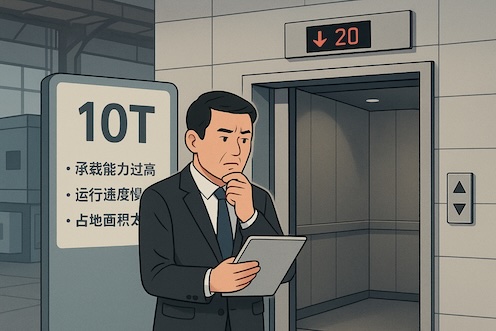In a national industrial park in the Yangtze River Delta, a 20 story intelligent manufacturing center that is about to be put into use, which should have undertaken the vertical transportation mission of "zero failure, large capacity, and intelligence", unexpectedly became a "hot spot" for enterprise complaints.

Overloading Illusion: Confusion between Freight Elevators and Passenger Elevators
The so-called '10 ton cargo elevator' performs poorly in practice:
Structural risk: guide rail deformation of 12mm (national standard ≤ 5mm), car inclination exceeding 3 °;
Low efficiency: The speed is only 0.5m/s, and it takes 25 minutes to transport one piece of equipment (demand ≤ 15 minutes);
Cost black hole: occupying 2.3 times the area of a passenger elevator, resulting in an annual rental loss of over 2 million yuan.
Standard scheme (GB50041-2016): 3-5 ton passenger and freight dual-use elevator, reinforced guide rail design, IoT diversion → efficiency improvement of 40%.
"Face Disaster": Conflict between gimmick and practicality
The "face+voice control" elevator brings a series of problems:
Recognition failure: The recognition rate after wearing a helmet and mask is only 58%;
System crash: Noise interference → Random layer rate reaches 27%;
Privacy breach: Data leakage of core technical personnel.
Research results: 83% of enterprises value reliability more than intelligence; 76% of workers prefer card swiping; 62% of enterprises are willing to pay an additional 15% for a "99.99% failure free rate".
The "Green Trap": The Contradiction between Energy Conservation and Stability
The actual operating effect of A-level energy-saving elevators is counterproductive:
Unstable operation: low-speed shaking exceeds the standard by 3 times, with a failure rate of+40%;
Expensive maintenance: The cost of specialized lubricants is 2.5 times that of regular lubricants;
Higher energy consumption: frequent use of backup power → comprehensive energy consumption increases by 8%.
Test results: Energy efficiency level is negatively correlated with stability (r=-0.72). Truly efficient solution: intelligent group control+solar assisted power supply.
The "Maintenance Trap": The Game between Low Price and Safety
Low price contract (380000 yuan/5 years) brings serious consequences:
Poor quality accessories: Using refurbished steel wire rope, 2 ladder accidents occurred within 3 months;
Service delay: promised 30 minutes, actual average 2 hours and 15 minutes;
Data falsification: The record states "two maintenance", but it is actually one.
Regulatory inspection: 76% of low-priced contracts reduce service quality; 43% of faults are caused by improper maintenance.
The way to break through: "Performance Commitment System"
Pilot of Guangdong Hong Kong Macao Greater Bay Area:
Performance bet: MTBF ≥ 8000 hours, fault response ≤ 15 minutes;
Digital twin: 500+sensors monitor 127 parameters in real-time;
Centralized maintenance: Unified procurement by regional centers, reducing accessory costs by 30%;
Insurance linkage: linking premiums with operational data, forcing quality improvement.
Effect: The failure rate has decreased by 92%, complaints have decreased by 87%, and the property fee collection rate has reached 99.5%.
Conclusion
Elevators have evolved from a means of transportation to a factor of production. Only by managing with manufacturing thinking and optimizing with industrial Internet logic can the industrial park truly achieve the upgrading goal of "efficiency is competitiveness".
If you would like to obtain a more detailed solution, please contact us.
